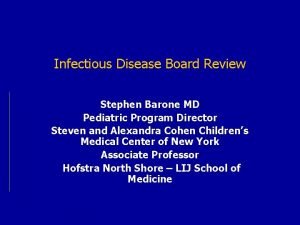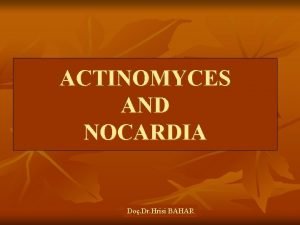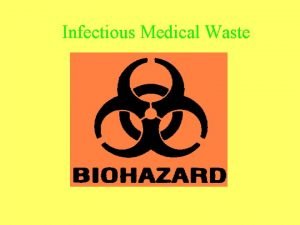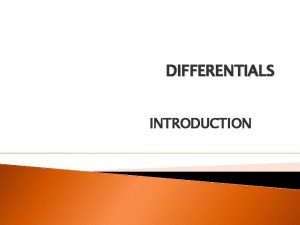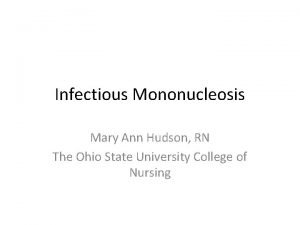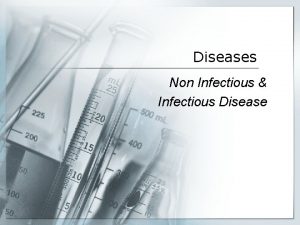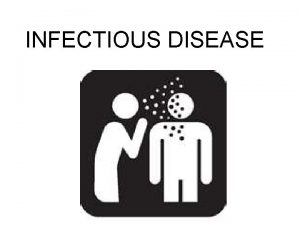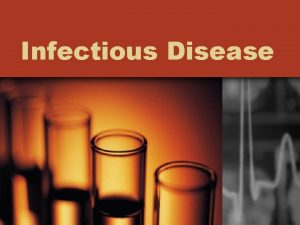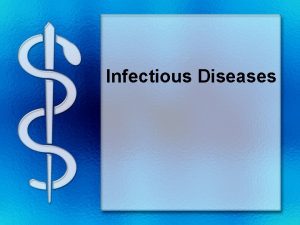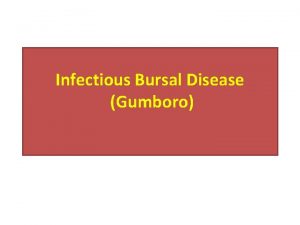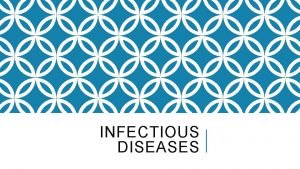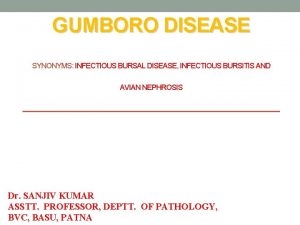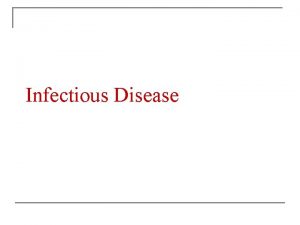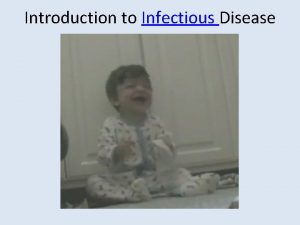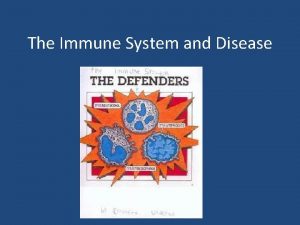INFECTIOUS DISEASE Infectious Disease Process NATURE OF INFECTIOUS



















- Slides: 19

INFECTIOUS DISEASE Infectious Disease Process

NATURE OF INFECTIOUS DISEASES l Pathogens: microorganisms that are capable of causing disease l Infection: results when a pathogen invades and begins growing within the host l Disease: results only if and when tissue function is impaired (i. e. burns, skin lesions)

Continued… l l l The body has defense mechanisms to prevent infection In order to cause disease, pathogens must be able to enter, adhere, invade, colonize, and inflict damage Entrance to the host: mouth, eyes, genital openings, wounds Growth of pathogens or the production of toxins/enzymes cause disease Some normal flora prevent diseases

MICROBES THAT CAUSE INFECTIOUS DISEASES l Bacteria: Salmonella typhi, Staphylococcus aureus Morphology: bacillus, coccus, spirillum ¡ Aerobes vs anaerobes ¡ Gram-negative (salmonella) vs gram-positive (staphylococcus) ¡ l Viruses: apart from the host cell, have no metabolism and cannot reproduce ¡ ¡ ¡ Retroviruses: HIV and certain types of cancer Herpes viruses: chicken pox, cold sores, smallpox Rhinoviruses: common colds – mutation (rapid) leads to no vaccine available Myxoviruses & paramysoviruses: influenza, measles, mumps Rotaviruses: gastroenteritis

Continued… l Fungi: form spores ¡ Examples include ringworm and histoplasmosis ¡ Yeasts of Candida genus are opportunistic ¡ Antibiotics reduces normal flora, allowing yeast to grow l Protoza: acquired through contaminated food or water, or bite of an arthropod (mosquito) ¡ Diarrheal disease in the US – Giardia lamblia and Cryptosporidium parvum ¡ Malaria – Plasmodium (in tropical environment)

… l Helminths: simple invertebrate animals, some infectious parasites ¡ ¡ ¡ l Symptoms: abd. pain and diarrhea Swimmer’s itch in US – flatworm, Schistosoma Trichinella spiralis – roundworm which is ingested in undercooked pork from infected pigs (Cause of death = respiratory paralysis) Prions-Creuzfeldt-Jakob disease ¡ ¡ ¡ A rare, degenerative, invariably fatal brain disorder; believe caused by an unusual "slow virus" or another organism Typically, onset of symptoms occurs about age 60, and about 90 percent of individuals die within 1 year. characterized by rapidly progressive dementia and they eventually lose the ability to move and speak and enter a coma





Malaria

Giardia and Cryptosporidium

Helminths Worm

Prions-Creuzfeldt-Jakob disease

OCCURANCE OF INFECTIOUS DISEASES Epidemiology: study of the occurence of disease in populations l Disease reservoirs: where the infectious agent survives (human, rodents) l ¡ l Example: yersinia pestis Modes of transmission ¡ ¡ ¡ Direct contact: occurs when a person is infected by contact with reservoir, inhaling infectious droplets – examples are AIDS, rabies, malaria, influenza, ringworm, trichninosis Indirect contact: the pathogen is transmitted from contaminated substances such as food, soil, water (Hepatitis A), clothing, equipment (example – tetanus) Horizontal vs vertical transmission l l Horizontal: transmission between individuals specifically who are not related as a parent is to its offspring Vertical: occurs from parent to offspring, e. g. , in utero, during passage down the birth canal, or in breast milk

HOST DEFENSES AGAINST INFECTIOUS DISEASES l Nonspecific mechanisms are the body’s primary defense against disease - anatomical barriers, physiological deterrents and presence of normal flora (skin, low p. H and high salinity) ¡ ¡ ¡ l Specific mechanisms: immunity ¡ ¡ ¡ l Anatomical barriers: nasal opening, skull, vertebral column, skin Physiological deterrents: tears, vaginal secretions, saliva, blood, sweat, and some tissue fluids Normal flora: successfully compete with pathogens Cell-mediated: uses T-cells; helper cells and killer cells; activate B cells Antibody-mediated: uses B-cells Both are lympatic cells Vaccination: produces immunity



 Infectious disease quality controls
Infectious disease quality controls Types of infection
Types of infection Chapter 26 infectious disease prevention and control
Chapter 26 infectious disease prevention and control Stages of infectious disease
Stages of infectious disease Infectious disease board review
Infectious disease board review Infectious disease
Infectious disease Hennepin county infectious disease manual
Hennepin county infectious disease manual Smallest infectious agents
Smallest infectious agents Communicable disease and non communicable disease
Communicable disease and non communicable disease Nature and nature's law lay hid in night
Nature and nature's law lay hid in night Determinace lidské psychiky
Determinace lidské psychiky Infectious waste meaning
Infectious waste meaning Infectious canine hepatitis in dogs
Infectious canine hepatitis in dogs Icd 10 morbus hansen
Icd 10 morbus hansen Papillomitosis
Papillomitosis Infectious nucleic acid
Infectious nucleic acid Infectious mononucleosis
Infectious mononucleosis Ebv
Ebv Epidemiological triad of malaria
Epidemiological triad of malaria Snc set symbol
Snc set symbol




